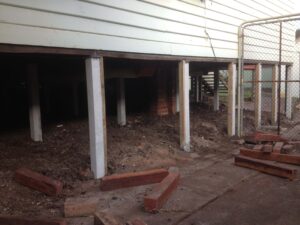Reblocking
House reblocking, also known as restumping, is the process for removal of old wooden stumps that are set beneath a building or a home, then replacing them using durable concrete stumps to ensure the stability of house foundations.
This is a process where you simply work to replace timber stumps with concrete stumps. If your home happens to be sitting on top of red gum stumps, they will have to be removed and then replaced by concrete stumps.
This will be common problem in solid brick, weatherboard or brick veneer homes. Major indicators that you can look for in the house will be plaster walls that are showing the signs of cracking, windows and doors that may not be shutting properly, unlevelled noisy floors and your home is sloping to one side and not level.
The aging stumps could be rotting from damp conditions, there could be a termite infestation, or the stumps could be sinking if they were not set into a solid base.
Working to stabilise the home using hydraulic jacks will be important for securing the home while the stumps are replaced.
If your home is sitting on concrete stumps already and you are noticing some of the above signs it doesn’t always mean a complete change of stumps. Sometimes, it could involve hanging some extra stumps that will prevent the further cracking, then taking on levelling to the rest of the floor. There might be times when you simply need levelling by way of packing, which will depend on the severity of the house.
Conclusion
Reblocking and restumping are essential processes that can help ensure your home’s foundation is stable and secure. By understanding what to expect during the reblocking process, the importance of house restumping, and the benefits of additional services, you can make informed decisions about your home’s foundation. Contact a reblocking expert today to schedule a free quote and ensure your home’s foundation is secure for years to come.









